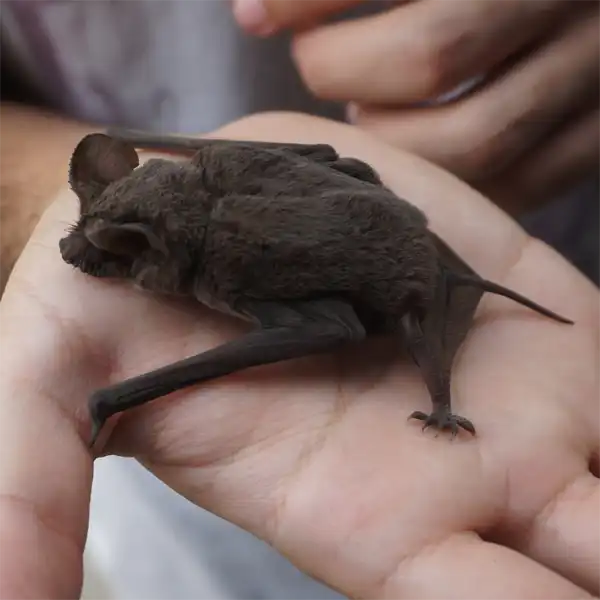Brazilian Free-Tailed Bat
- Scientific Name
- Tadarida brasiliensis
- Also Known As
- Mexican Free-tailed Bat
- Range
- All of Florida
- Diet
- Moths, Beetles, Dragonflies, Flies, Ants, Wasps
- Life Expectancy
- 8 - 10 Years
Quick Links
Brazilian Free-Tailed Bats in Central Florida
The Brazilian free-tailed bat (Tadarida brasiliensis) is a highly adaptable bat species found across the southern United States, including central Florida. As the name suggests, this bat has a distinctive tail that extends beyond the tail membrane, giving it greater agility in flight. This comprehensive guide provides detailed identification tips, biology facts, and control methods for Brazilian free-tailed bats in central Florida.
Read on to learn about their habits, reproduction, diet, health risks, signs of infestation, and professional exclusion options if you suspect an invasion on your property.
Appearance and Identification
Brazilian free-tailed bats can be identified by their physical characteristics
Maturation Rate
Pups grow rapidly after birth, reaching full adult size in 6 weeks. They are sexually mature at 1 year old. The average maturation rate allows populations to rebound quickly after pest control efforts. Diligent, ongoing management is key.
Habits and Behavior
Brazilian free-tailed bats roost in very large colonies of up to 1 million individuals in caves, under bridges, and in building attics and roofs. They emerge at dusk in spiraling clusters to feed. Their flight can reach speeds over 60 mph aided by their aerodynamic tails.
Brazilian free-tailed bats are highly social. Hundreds to thousands cluster together when roosting. They groom each other frequently. Their large colonies provide protection through shared body heat and humidity.
Reproduction and Lifespan
Mating occurs in flight. Females give birth to a single pup in May through July after ~3 month gestation. Pups cannot fly for 3-4 weeks. Maximum lifespan in the wild is about 8-10 years.
Ideal Habitat and Range
Central Florida’s humid subtropical climate offers ideal roosting and foraging conditions for Brazilian free-tailed bats. Average temperatures range from 60sF to 90sF (15-32C) with moderate rainfall. Urban centers provide roost sites under bridges, in parks with palm trees, and on high-rise buildings. Rural areas offer foraging over wetlands, pastures, and citrus groves.
The abundance of flying insects sustains large colonies. Brazilian free-tailed bats exploit these rich insect populations, with access to plentiful roosts and warmth needed to rear young. Their high reproductive rate allows Brazilian free-tailed bats to thrive in central Florida.
Diet and Feeding
Brazilian free-tailed bats are insetivores and feed almost exclusively on insects. They eat:
- Moths
- Beetles
- Dragonflies
- True flies
- Wasps
- Mayflies
They use echolocation to hunt insects on the wing at night. A single bat can consume over half its body weight in insects each night. Large colonies require massive insect populations, migrating seasonally to track emerging hatches.

Photo 423714 © Juan Ramirez, CC BY-NC

Common Health Risks
Brazilian free-tailed bats pose some health risks through accumulation of guano and contact with people:
- Histoplasmosis – Fungal infection from spores in guano accumulated in attics and walls. Causes flu-like illness.
- Rabies – Rare but bats could spread through bites if handled. Nearly always fatal viral disease.
- Ectoparasites – Bats share roosts with bat bugs, mites, fleas, and ticks which can bite people.
Preventing Brazilian Free-Tailed Bat Colonies
The key is bat-proofing potential roost sites by sealing openings to make buildings inhospitable. This may involve:
- Installing one-way exclusion devices on vents and chimneys.
- Sealing gaps under eaves, fascia boards, and soffits using steel wool or caulk.
- Covering vent openings with fine mesh Screens.
- Trimming back trees and vegetation touching the building.
Trapping and relocation of smaller colonies is also an option using professional bat control methods. Prevent contact with guano accumulations found in attics and walls by wearing PPE. Seek medical attention for flu symptoms after exposure.
Brazilian Free-Tailed Bats in Central Florida – Conclusion
With their high reproductive potential and ability to exploit urban areas, Brazilian free-tailed bats readily colonize central Florida. However, through active monitoring and exclusion efforts focused on sealing potential roost sites, large infestations can be prevented. Their preference for building crevices means bat-proofing measures are highly effective deterrents when applied properly. Continued vigilance is key to detecting and addressing small colonies before they expand. With early intervention, Brazilian free-tailed bats can be managed in central Florida.







